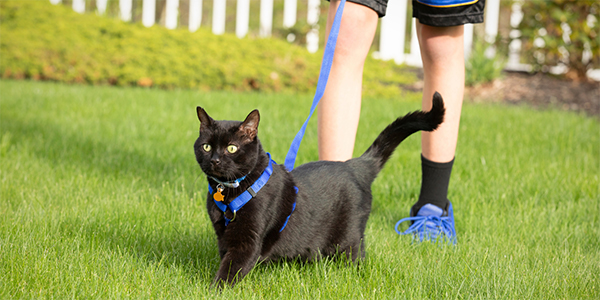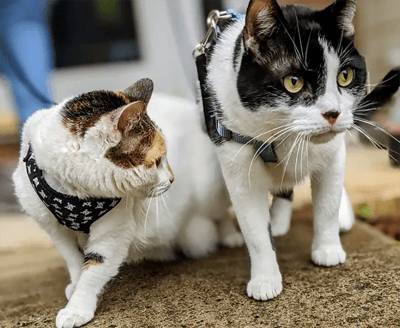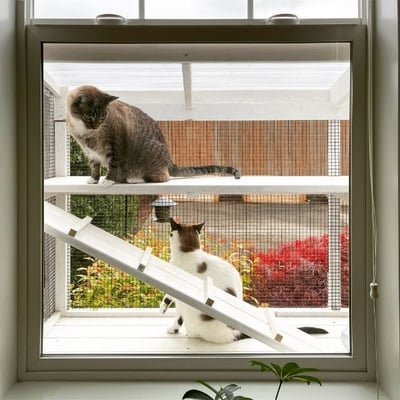
Walking a cat on a leash and harness comes with risks. It's important to understand those risks, what you can do to minimize them, and how to react in an emergency.
Why? Cats are not small dogs. They take in and respond to stimuli and triggers very differently than dogs do.
To keep your cat (and you) safe, it's vital to look at the outdoors through your cat's eyes, know a bit about why they do what they do, make informed decisions, and plan ahead so you can walk your cat on leash safely.
Skip Ahead
Challenges of Walking Your Cat on a Leash and Harness
They may be called "domestic" house cats. But they aren't all that domesticated. We don't breed cats to tweak their natural instincts and characteristics to fit our lifestyles.
In fact, the only thing cats are bred for specifically is appearance. This means they still have many of the same instincts as their ancient ancestors.
These instincts impact the way they react to things like catching the scent of another cat, seeing a prey item like a bird woosh by, or coming face-to-face with a potential predator.
All of these scenarios are possible when walking your cat. So, how might they react?
 A cat coming upon another cat's scent may become nervous, fearful, or agitated. These emotions can very easily escalate into aggression, particularly if you try to pick them up. I've experienced this first-hand, as have many of my clients.
A cat coming upon another cat's scent may become nervous, fearful, or agitated. These emotions can very easily escalate into aggression, particularly if you try to pick them up. I've experienced this first-hand, as have many of my clients.
Cats are predators. They don't just hunt for food. It's an instinctual need. And a bird or squirrel crossing your path could mean your cat suddenly goes from standing still to running 20 MPH before you know what's happening.
Cats are also prey. If they come upon a potential predator (even another cat), they go into "fight, flight, or freeze" mode. None of these are what you want when you're on a walk.
A fighting cat is dangerous to themselves, the other animal, and you. As we discussed above, you'll have a hard time keeping up with a cat in flight. Trust me, I've tried. And a frozen cat is in danger themselves and can redirect their fear aggression toward you if you try to pick them up.
No harness is escape-proof. Cats can turn into liquid and slip or roll out of any harness, especially in times of distress.
All of this may sound intimidating. But it's stuff you need to be aware of if you're going to take your cat for a walk. Don't worry! If you think leashed walks are right for your cat after reading our articles on cat harnesses and leash/harness training, there are things you can do to be better prepared.

Important Safety Tips for Walking Your Cat Outside
Use a Cat Harness
You absolutely should not attach a leash to a standard collar around your cat's neck. You've seen videos of alligators doing the death roll when someone gets a lead around their snout. That's pretty much what a cat will do if they get scared. Talk about a dangerous situation for the cat if they're only secured around the neck.
They can also jump more than four feet in the air. At some point, your cat will make a leap up a tree trunk or try to get over a fence — another dangerous situation for a collar. Harnesses give you much better control.
Take it Slow!
Cats like to be in control of the situation, and they appreciate having choices. That's how you avoid fear and panic. It is better to open the door, pick them up, and set them down just outside the door than to plop them in the middle of the front lawn.
Let them decide how quickly they want to step out and how far they want to go (within reason). If you can do so safely, you might leave the door open, so they have a clear path of retreat if they get nervous.
Pro Tip: While it may seem better to give your cat the option to walk from inside to outside on their own, that can bite you in the backside. Cats move quick. Once they're comfortable going outside, they may be more prone to door dashing.
You can mitigate this somewhat by only allowing them outside if they are picked up while inside and carried to just outside the door.
Use a Cat Carrier as a Place to Retreat
You might even have it sitting open on the ground nearby. If something startles your cat, they can run into the carrier instead of the bushes. Remember, a scared cat may react with aggression.
You want to avoid picking your cat up if they seem agitated or fearful. Use the carrier instead! It can also be a good idea to bring a towel along in case you need to help them into the carrier while protecting yourself from their murder mitts.
Train Your Cat to Walk on a Leash and Harness First
Once you have successfully taught your cat to walk on a leash and harness inside — and they are comfortable with it — continue the training work outside. You can learn more about that in How to Train Your Cat to Walk on a Leash.
As they get comfortable, take them through any commands they've learned and provide lots of positive reinforcement as they expand their territory, smell new things, and hear new sounds.
But keep in mind that in a tense situation, cats are more likely to act on instinct rather than follow a cue or look to their human for direction.
Stay Close to Home
At least initially, walking in your own yard may be your safest bet. You and your cat should be incredibly comfortable outside and have some training in place if you want to go beyond your yard. If you're in an apartment or condo building, consider walking in the hallways and corridors before moving outside.
Don’t Use a Retractable Leash
They may seem convenient — but they’re risky. If you don’t have the leash locked and your cat decides to try and go 0 to 60 MPH in 3.6 seconds like a Ferrari, you’ll be fumbling to get it locked, your cat might get jerked violently, or you may drop the leash altogether.
It’s also important to keep your cat close so they can’t scamper up a tree or over a fence. A short (4 feet is best), sturdy leash is a safer option all around.

Know the Area
If you know cats, raccoons, or other critters hang out in parts of your yard or surrounding areas, consider avoiding these areas or use caution. Cats respond dramatically and instinctively to scent.
Think about some cats' reactions when their sibling cat comes home smelling like the vet. I've even seen cases where cats react aggressively to people smelling like the outside when they come home after work.
It's also a good idea to do a little reading on local plant life. Cats will eat grass and other greenery if given a chance. Identifying plants that may be toxic to your cat, like lilies, will give you some peace of mind.
They're also going to eat a lot of grasshoppers. Prepare yourself for a little insect destruction.
Be Alert
If you see something that may upset your cat in the distance, end the walk or move to another area quickly. This could be another cat, a dog, a loud car, or even people on the sidewalk.
Over time, your cat will get more comfortable with a variety of stimuli, and you'll learn how they react to different things.
Know What to Expect
"Walking" your cat may not be the most accurate term for many cats. It's often less about walking and exercise and more about letting them sniff and explore. I think most cats would be just as happy staying in a familiar five-square-foot area outside as they would be walking the neighborhood.
In fact, many would probably feel a bit more secure sticking to a smaller space. So, don't feel like you're doing your cat a disservice if you're not covering a lot of ground.
Make Sure Your Cat Has ID Tags!
It's essential to ensure your cat can be identified if they happen to escape their harness and take off. Microchipping and a breakaway collar with an ID tag and your current contact info are a must.
Cat Vaccines and Parasite Prevention
Before you head out, ask your veterinarian for their advice about which vaccinations and parasite prevention are needed. Cats can be exposed to some nasty critters and serious diseases, even in their own backyard.
Recommended vaccines generally include Feline Leukemia Virus (FeLV), rabies, and the combo FVRCP that covers Feline Rhinotracheitis Virus, Feline Calicivirus, and Feline Panleukopenia. Flea, tick, and heartworm preventatives are important as well.
How to Know if Your Cat Is Scared or Uncomfortable Outside
Cats don't always make it easy for us to figure out how they're feeling. It's easy to confuse the signs of fear, territoriality, or general stress and anxiety. But, in this case, if your cat is feeling any of these, it's best to take a step back, do a bit more training, and move more slowly.
Beyond the obvious indicators like hissing, puffing up, or trying to run away, here are some signs your cat may be feeling stressed or uncomfortable outside:
- Lowered and tucked body posture as if they're trying to look smaller
- Not wanting to move or trying to run away
- Locking in a stare on an object or animal
- Eyes and head darting around like they don't know where to look
- Dilated or slit-like pupils
- Body posture up and forward as if they're trying to look larger
- Puffed tail
- Vocalizing
- Ears back or down to the side
- Tail tucked or hooked
Alternatives to Walking Your Cat on a Leash
If your cat isn't comfortable going for walks — or for that matter, if you're not comfortable taking your cat for walks — don't despair. There are other ways to keep your cat active and happy that provide a bit more security.
Catios
 A catio can be a great option to let your cat experience the sights, sounds, and smells of the outdoors while staying protected.
A catio can be a great option to let your cat experience the sights, sounds, and smells of the outdoors while staying protected.
They range from simple DIY versions you can pop on the patio (think big chicken coop) to framed and screened additions to your home that they access through a cat door, and everything in between.
Cat Strollers and Cat Backpacks
You may have seen cat strollers and backpacks. Strollers are a nice option — essentially a cat carrier on wheels that allows you to take your cat outside while keeping them secure inside a canopy enclosure.
Do some training first to get them comfortable with the stroller before you head down the street. Even though it’s recreational, it still means your cat is forced into an enclosed space (much like their carrier), and it can be stressful if they aren’t desensitized to it.
I’m not a big fan of the backpack options. They’re basically a very small carrier with a plastic window that you wear on your back. They’re too small for most cats to feel comfortable. They bounce around, so your cat won’t feel stable.
And if you’re wearing it on your back, you can’t see how your cat is doing. They could be scared or stressed, and you wouldn’t know it. I’d only consider these if your cat is extremely comfortable outside, doesn’t mind being in a small carrier at all, and you stay super focused on how they’re handling it.
Indoor Cat Enrichment
If you're all indoors, all the time, that's O.K. too. Try bringing a little of the outdoors in (or at least closer). Hang bird and squirrel feeders near windows where your cat can watch them. Bring things in from outside that they can sniff and investigate, like branches and rocks. Just make sure they don't eat anything they shouldn't.
Some cats enjoy watching wildlife videos on TV or on a tablet. In fact, they make videos specifically for cats. Veterinary clinics and shelters often place a tablet in the cats' kennels so they can watch the critters.
We've even made a few for our cats!
Check out What to Do if Your Cat is Bored for more enrichment ideas.
Cats need enrichment to live full, happy lives. Controlled walks outside are a wonderful way to let them explore and flex those furry wildcat muscles. Just keep in mind the outdoors can be intimidating and overwhelming if your cat (and you) aren't prepared.
Take your time. Do some training for yourself and your cat. Be prepared for anything. But most of all, trust your instincts and enjoy this bonding time with your cat. Listen to what their body language is telling you. They'll let you know what they're ready for. And you can follow alongside. 
My Own Experience Training My Cat to Walk on Leash
Even as a certified feline behavior and training specialist, I still find myself in unexpected situations with my cat. This particular situation is a great (though unfortunate) example of cats acting on instinct above all else.
In this case, we were taking a harnessed walk through the backyard. I let my cat wander to an area where the neighborhood cat likes to hang out. He started sniffing around and getting upset. I picked him up to move him out of the area, which, as you read above, isn't the best idea.
Naturally, he hissed and yelled at me, but we were O.K. Then he saw our other cat in the catio. This is a cat he'd lived with for 2 years. Not a stranger. A housemate. But he was already freaked out about the intruder cat smells and my prematurely removing him from that investigation.
He wasn't thinking logically as a person might in this situation. He was using cat logic. Predator or prey? Fight or flight? He saw his housemate cat and lost his kitty mind. I was badly scratched.
He fell to the ground trying to death roll out of his harness so he could run away.
I managed to get him in the catio (after my other cat exited, of course). For the next 4 hours, I couldn't take a step toward the catio without him growling and hissing at me.
So, what happened? He got worked up over the smell of an intruder cat, which is absolutely normal cat behavior. I picked him up when he was in a heightened state of arousal, removing his control over the situation.
He didn't recognize my other cat, and his instincts kicked in. He thought he was being forced into a battle and reacted in a completely reasonable way, from a cat's perspective. And then he made an association between that terrifying event and me.
So, he didn't want me anywhere near him for a while.
If we'd been away from the house and not prepared with a carrier on hand, who knows how this would have ended?
That's why I take such a slow, calculated approach to harness training and managing cat time outdoors. It keeps you and your feline family members safe and happy!





